stop start Citroen DS4 RHD 2013.5 1.G Owner's Guide
[x] Cancel search | Manufacturer: CITROEN, Model Year: 2013.5, Model line: DS4 RHD, Model: Citroen DS4 RHD 2013.5 1.GPages: 400, PDF Size: 31.86 MB
Page 201 of 400
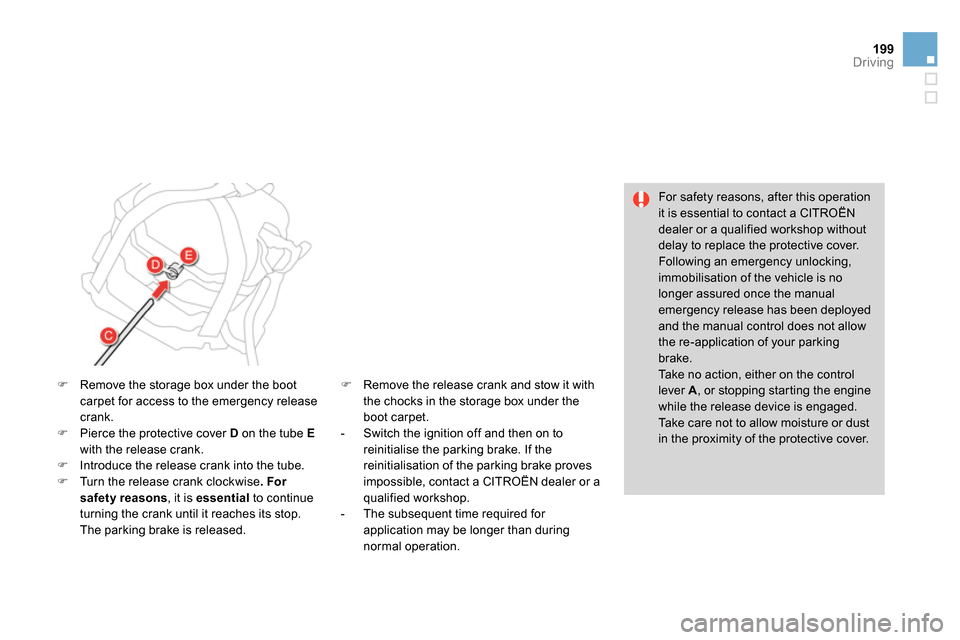
199Driving
For safety reasons, after this operation
it is essential to contact a CITROËN
dealer or a qualified workshop without
delay to replace the protective cover.
Following an emergency unlocking,
immobilisation of the vehicle is no
longer assured once the manual
emergency release has been deployed
and the manual control does not allow
the re-application of your parking
brake.
Take no action, either on the control
lever A
, or stopping starting the engine
while the release device is engaged.
Take care not to allow moisture or dust
in the proximity of the protective cover.
Remove the storage box under the boot
carpet for access to the emergency release
crank.
Pierce the protective cover D
on the tube E
with the release crank.
Introduce the release crank into the tube.
Turn the release crank clockwise .
For
safety reasons
, it is essential
to continue
turning the crank until it reaches its stop.
The parking brake is released.
Remove the release crank and stow it with
the chocks in the storage box under the
boot carpet.
- Switch the ignition off and then on to
reinitialise the parking brake. If the
reinitialisation of the parking brake proves
impossible, contact a CITROËN dealer or a
qualified workshop.
- The subsequent time required for
application may be longer than during
normal operation.
Page 218 of 400
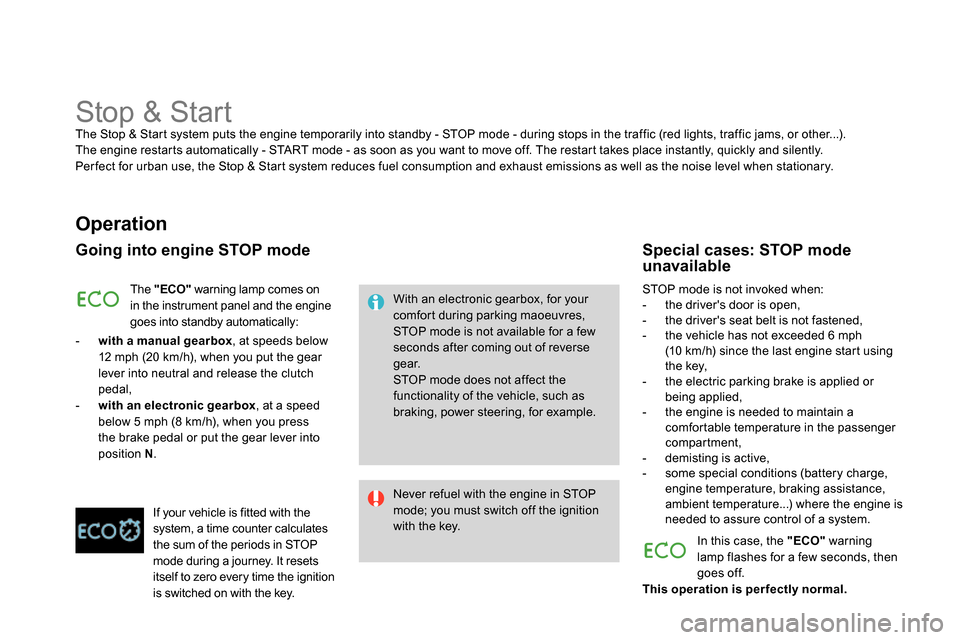
Stop & Start
The Stop & Start system puts the engine temporarily into standby - STOP mode - during stops in the traffic (red lights, traffic jams, or other...).
The engine restarts automatically - START mode - as soon as you want to move off. The restart takes place instantly, quickly and silently.
Per fect for urban use, the Stop & Start system reduces fuel consumption and exhaust emissions as well as the noise level when stationary.
Operation
Going into engine STOP mode
With an electronic gearbox, for your
comfort during parking maoeuvres,
STOP mode is not available for a few
seconds after coming out of reverse
gear.
STOP mode does not affect the
functionality of the vehicle, such as
braking, power steering, for example.
Never refuel with the engine in STOP
mode; you must switch off the ignition
with the key. The "ECO"
warning lamp comes on
in the instrument panel and the engine
goes into standby automatically:
- with a manual gearbox
, at speeds below
12 mph (20 km/h), when you put the gear
lever into neutral and release the clutch
pedal,
- with an electronic gearbox
, at a speed
below 5 mph (8 km/h), when you press
the brake pedal or put the gear lever into
position N
.
If your vehicle is fitted with the
system, a time counter calculates
the sum of the periods in STOP
mode during a journey. It resets
itself to zero every time the ignition
is switched on with the key. STOP mode is not invoked when:
- the driver's door is open,
- the driver's seat belt is not fastened,
- the vehicle has not exceeded 6 mph
(10 km/h) since the last engine start using
the key,
- the electric parking brake is applied or
being applied,
- the engine is needed to maintain a
comfortable temperature in the passenger
compartment,
- demisting is active,
- some special conditions (battery charge,
engine temperature, braking assistance,
ambient temperature...) where the engine is
needed to assure control of a system.
Special cases: STOP mode
unavailable
In this case, the "ECO"
warning
lamp flashes for a few seconds, then
goes off.
This operation is per fectly normal.
Page 219 of 400
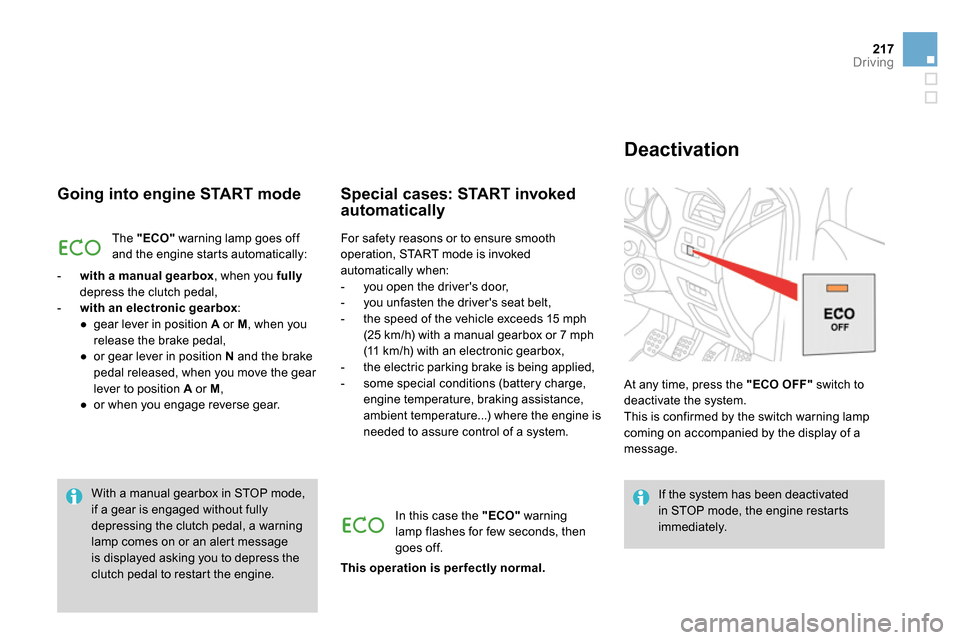
217Driving
Going into engine START mode
The "ECO"
warning lamp goes off
and the engine starts automatically:
- with a manual gearbox
, when you fully
depress the clutch pedal,
- with an electronic gearbox
:
●
gear lever in position A
or M
, when you
release the brake pedal,
●
or gear lever in position N
and the brake
pedal released, when you move the gear
lever to position A
or M
,
●
or when you engage reverse gear.
Special cases: START invoked
automatically
If the system has been deactivated
in STOP mode, the engine restarts
immediately. With a manual gearbox in STOP mode,
if a gear is engaged without fully
depressing the clutch pedal, a warning
lamp comes on or an alert message
is displayed asking you to depress the
clutch pedal to restart the engine.
At any time, press the "ECO OFF"
switch to
deactivate the system.
This is confirmed by the switch warning lamp
coming on accompanied by the display of a
message.
Deactivation
In this case the "ECO"
warning
lamp flashes for few seconds, then
goes off.
This operation is per fectly normal.
For safety reasons or to ensure smooth
operation, START mode is invoked
automatically when:
- you open the driver's door,
- you unfasten the driver's seat belt,
- the speed of the vehicle exceeds 15 mph
(25 km/h) with a manual gearbox or 7 mph
(11 km/h) with an electronic gearbox,
- the electric parking brake is being applied,
- some special conditions (battery charge,
engine temperature, braking assistance,
ambient temperature...) where the engine is
needed to assure control of a system.
Page 220 of 400
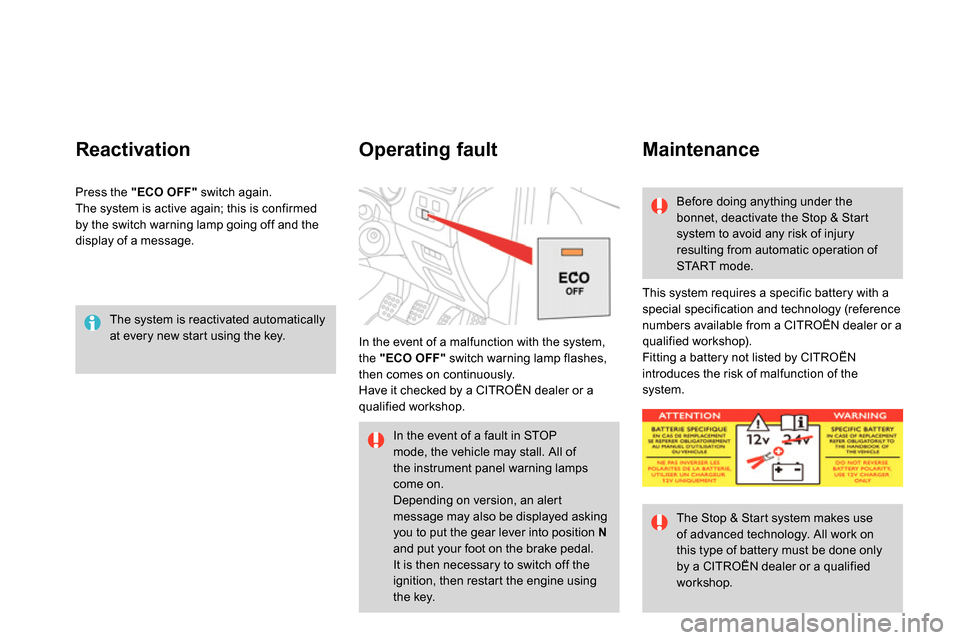
The system is reactivated automatically
at every new start using the key.
Reactivation
This system requires a specific battery with a
special specification and technology (reference
numbers available from a CITROËN dealer or a
qualified workshop).
Fitting a battery not listed by CITROËN
introduces the risk of malfunction of the
system. In the event of a malfunction with the system,
the "ECO OFF"
switch warning lamp flashes,
then comes on continuously.
Have it checked by a CITROËN dealer or a
qualified workshop.
Operating fault
Maintenance
Before doing anything under the
bonnet, deactivate the Stop & Start
system to avoid any risk of injury
resulting from automatic operation of
START mode.
The Stop & Start system makes use
of advanced technology. All work on
this type of battery must be done only
by a CITROËN dealer or a qualified
workshop. Press the "ECO OFF"
switch again.
The system is active again; this is confirmed
by the switch warning lamp going off and the
display of a message.
In the event of a fault in STOP
mode, the vehicle may stall. All of
the instrument panel warning lamps
come on.
Depending on version, an alert
message may also be displayed asking
you to put the gear lever into position N
and put your foot on the brake pedal.
It is then necessary to switch off the
ignition, then restart the engine using
the key.
Page 237 of 400
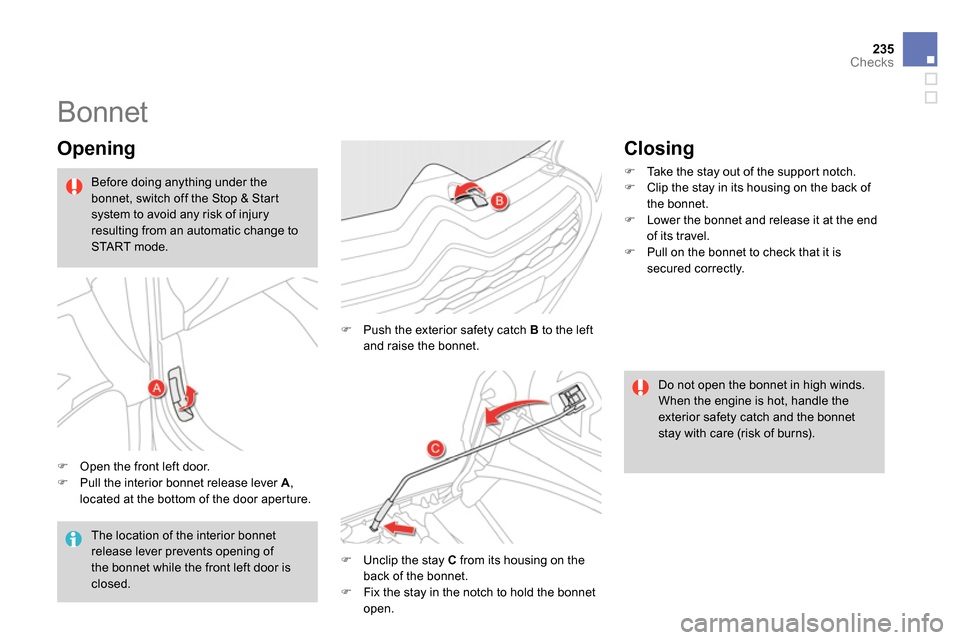
235Checks
Bonnet
Opening
Open the front left door.
Pull the interior bonnet release lever A
,
located at the bottom of the door aperture.
Push the exterior safety catch B
to the left
and raise the bonnet.
Unclip the stay C
from its housing on the
back of the bonnet.
Fix the stay in the notch to hold the bonnet
open.
The location of the interior bonnet
release lever prevents opening of
the bonnet while the front left door is
closed.
Do not open the bonnet in high winds.
When the engine is hot, handle the
exterior safety catch and the bonnet
stay with care (risk of burns).
Before doing anything under the
bonnet, switch off the Stop & Start
system to avoid any risk of injury
resulting from an automatic change to
START mode.
Closing
Take the stay out of the support notch.
Clip the stay in its housing on the back of
the bonnet.
Lower the bonnet and release it at the end
of its travel.
Pull on the bonnet to check that it is
secured correctly.
Page 244 of 400
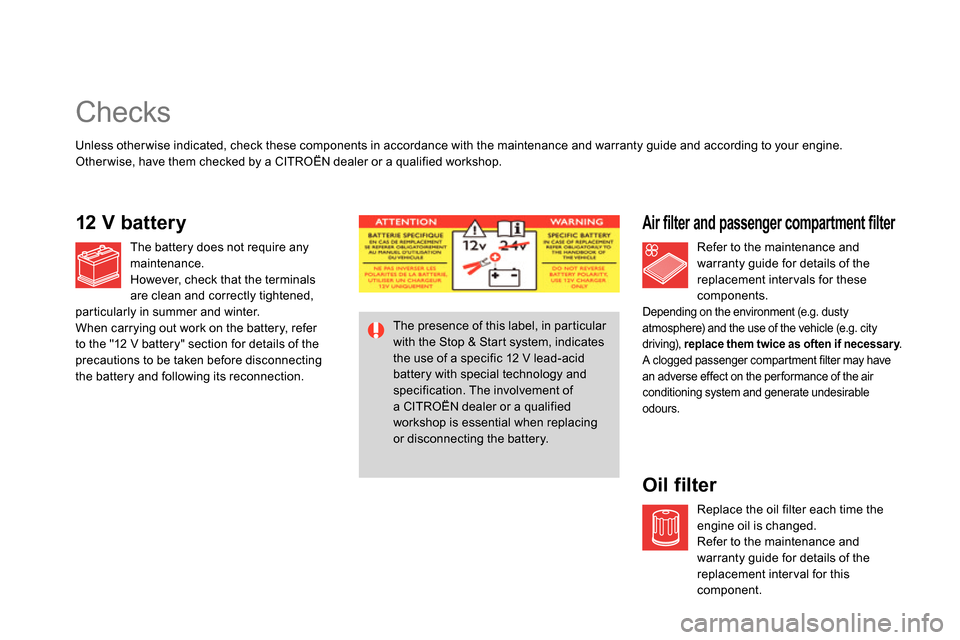
Checks
Air filter and passenger compartment filter
Oil filter
Unless other wise indicated, check these components in accordance with the maintenance and warranty guide and according to your engine.
Other wise, have them checked by a CITROËN dealer or a qualified workshop.
Refer to the maintenance and
warranty guide for details of the
replacement inter vals for these
components.
Depending on the environment (e.g. dusty
atmosphere) and the use of the vehicle (e.g. city
driving), replace them twice as often if necessar y
.
A clogged passenger compartment filter may have
an adverse effect on the per formance of the air
conditioning system and generate undesirable
odours.
Replace the oil filter each time the
engine oil is changed.
Refer to the maintenance and
warranty guide for details of the
replacement inter val for this
component.
The presence of this label, in particular
with the Stop & Start system, indicates
the use of a specific 12 V lead-acid
battery with special technology and
specification. The involvement of
a CITROËN dealer or a qualified
workshop is essential when replacing
or disconnecting the battery.
12 V battery
The battery does not require any
maintenance.
However, check that the terminals
are clean and correctly tightened,
particularly in summer and winter.
When carrying out work on the battery, refer
to the "12 V battery" section for details of the
precautions to be taken before disconnecting
the battery and following its reconnection.
Page 252 of 400
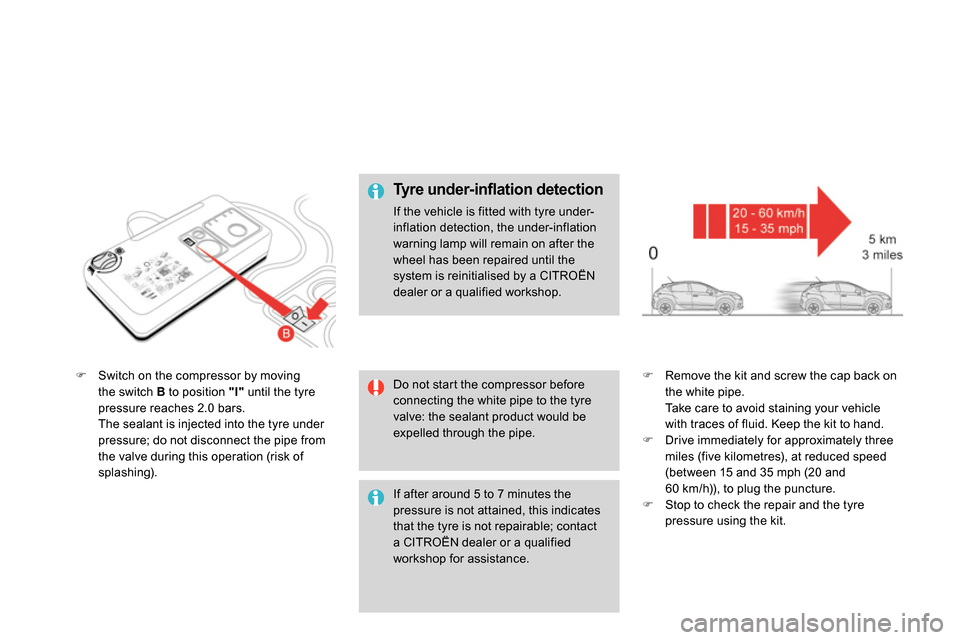
Switch on the compressor by moving
the switch B
to position "I"
until the tyre
pressure reaches 2.0 bars.
The sealant is injected into the tyre under
pressure; do not disconnect the pipe from
the valve during this operation (risk of
splashing).
Remove the kit and screw the cap back on
the white pipe.
Take care to avoid staining your vehicle
with traces of fluid. Keep the kit to hand.
Drive immediately for approximately three
miles (five kilometres), at reduced speed
(between 15 and 35 mph (20 and
60 km/h)), to plug the puncture.
Stop to check the repair and the tyre
pressure using the kit.
Do not start the compressor before
connecting the white pipe to the tyre
valve: the sealant product would be
expelled through the pipe.
Ty r e u n d e r - i nfl ation detection
If the vehicle is fitted with tyre under-
inflation detection, the under-inflation
warning lamp will remain on after the
wheel has been repaired until the
system is reinitialised by a CITROËN
dealer or a qualified workshop.
If after around 5 to 7 minutes the
pressure is not attained, this indicates
that the tyre is not repairable; contact
a CITROËN dealer or a qualified
workshop for assistance.
Page 276 of 400
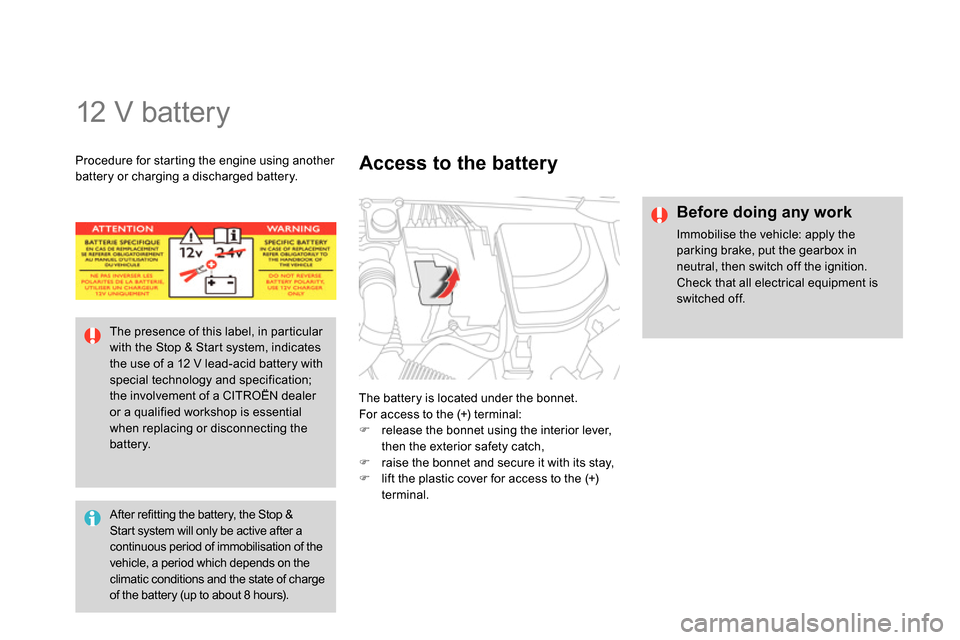
12 V battery
The battery is located under the bonnet.
For access to the (+) terminal:
release the bonnet using the interior lever,
then the exterior safety catch,
raise the bonnet and secure it with its stay,
lift the plastic cover for access to the (+)
terminal.
Access to the battery
After refitting the battery, the Stop &
Start system will only be active after a
continuous period of immobilisation of the
vehicle, a period which depends on the
climatic conditions and the state of charge
of the battery (up to about 8 hours).
The presence of this label, in particular
with the Stop & Start system, indicates
the use of a 12 V lead-acid battery with
special technology and specification;
the involvement of a CITROËN dealer
or a qualified workshop is essential
when replacing or disconnecting the
battery.
Before doing any work
Immobilise the vehicle: apply the
parking brake, put the gearbox in
neutral, then switch off the ignition.
Check that all electrical equipment is
switched off.
Procedure for starting the engine using another
battery or charging a discharged battery.
Page 278 of 400
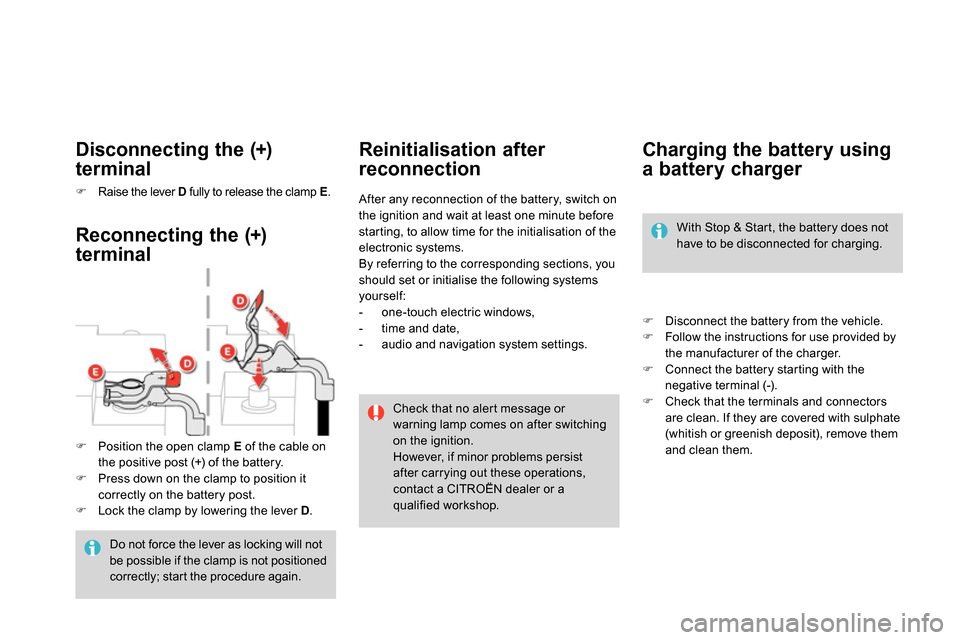
Charging the battery using
a battery charger
Disconnect the battery from the vehicle.
Follow the instructions for use provided by
the manufacturer of the charger.
Connect the battery starting with the
negative terminal (-).
Check that the terminals and connectors
are clean. If they are covered with sulphate
(whitish or greenish deposit), remove them
and clean them.
With Stop & Start, the battery does not
have to be disconnected for charging.
Reinitialisation after
reconnection
After any reconnection of the battery, switch on
the ignition and wait at least one minute before
starting, to allow time for the initialisation of the
electronic systems.
By referring to the corresponding sections, you
should set or initialise the following systems
yourself:
- one-touch electric windows,
- time and date,
- audio and navigation system settings.
Check that no alert message or
warning lamp comes on after switching
on the ignition.
However, if minor problems persist
after carrying out these operations,
contact a CITROËN dealer or a
qualified workshop.
Position the open clamp E
of the cable on
the positive post (+) of the battery.
Press down on the clamp to position it
correctly on the battery post.
Lock the clamp by lowering the lever D
.
Reconnecting the (+)
terminal
Disconnecting the (+)
terminal
Raise the lever D
fully to release the clamp E
.
Do not force the lever as locking will not
be possible if the clamp is not positioned
correctly; start the procedure again.
Page 280 of 400
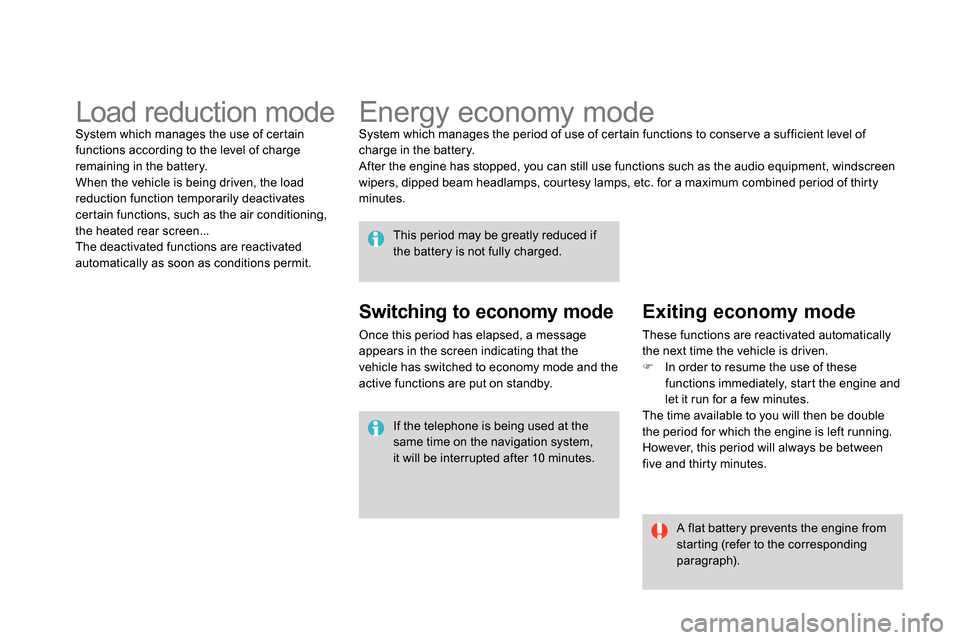
Energy economy mode
System which manages the period of use of certain functions to conser ve a sufficient level of
charge in the battery.
After the engine has stopped, you can still use functions such as the audio equipment, windscreen
wipers, dipped beam headlamps, courtesy lamps, etc. for a maximum combined period of thirty
minutes.
This period may be greatly reduced if
the battery is not fully charged.
A flat battery prevents the engine from
starting (refer to the corresponding
paragraph). If the telephone is being used at the
same time on the navigation system,
it will be interrupted after 10 minutes.
Switching to economy mode
Once this period has elapsed, a message
appears in the screen indicating that the
vehicle has switched to economy mode and the
active functions are put on standby.
Exiting economy mode
These functions are reactivated automatically
the next time the vehicle is driven.
In order to resume the use of these
functions immediately, start the engine and
let it run for a few minutes.
The time available to you will then be double
the period for which the engine is left running.
However, this period will always be between
five and thirty minutes.
Load reduction mode
System which manages the use of certain
functions according to the level of charge
remaining in the battery.
When the vehicle is being driven, the load
reduction function temporarily deactivates
certain functions, such as the air conditioning,
the heated rear screen...
The deactivated functions are reactivated
automatically as soon as conditions permit.